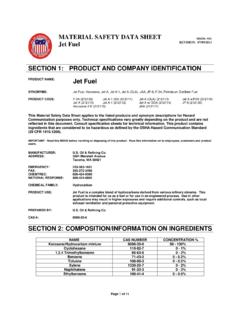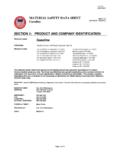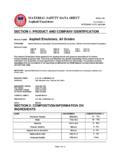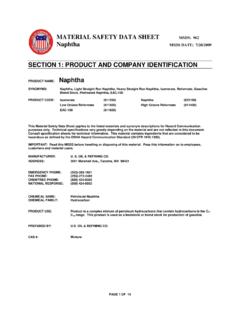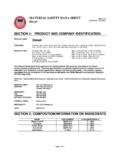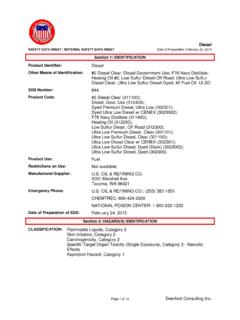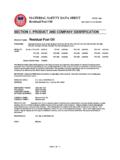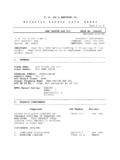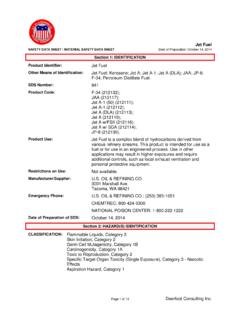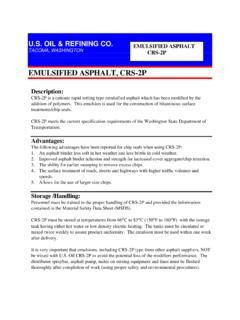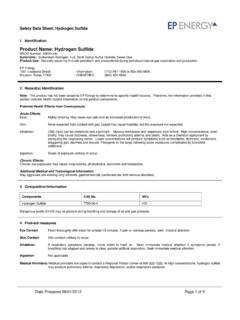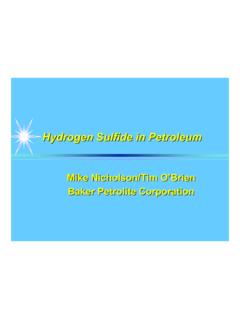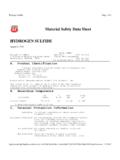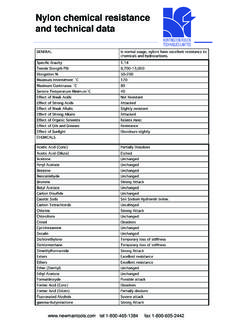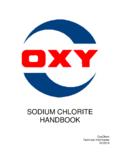Transcription of Vacuum Gas Oil - U.S. Oil and Refining
1 Vacuum Gas Oil SAFETY DATA SHEET / MATERIAL SAFETY DATA SHEET Date of Preparation: January 19, 2015 Page 1 of 11 Deerfoot Consulting Inc. Section 1: IDENTIFICATION Product Identifier: Vacuum Gas Oil Other Means of Identification: FCC Feedstock; Light Vacuum Gas Oil; Heavy Vacuum Gas Oil; Raw Vacuum Gas Oil. SDS Number: 644400 Product Code: Not available. Product Use: Refinery Feedstock. Restrictions on Use: Not available. Manufacturer/Supplier: OIL & Refining CO. 3001 Marshall Ave. Tacoma, WA 98421 Emergency Phone: OIL & Refining CO.: (253) 383-1651 CHEMTREC: 800-424-9300 NATIONAL POISON CENTER: 1-800-222-1222 Date of Preparation of SDS: January 19, 2015 Section 2: HAZARD(S) IDENTIFICATION CLASSIFICATION: Carcinogenicity, Category 1B LABEL ELEMENTS Hazard Symbol(s): Signal Word: Danger Hazard Statements: May cause cancer.
2 PRECAUTIONARY STATEMENTS Prevention: Obtain special instructions before use. Do not handle until all safety precautions have been read and understood. Wear protective gloves, protective clothing, eye protection and face protection. Response: If exposed or concerned: Get medical advice/attention. Storage: Store locked up. Disposal: Dispose of contents/container in accordance with applicable regional, national and local laws and regulations. Hazards Not Otherwise Classified: No applicable information was found. Vacuum Gas Oil SAFETY DATA SHEET / MATERIAL SAFETY DATA SHEET Date of Preparation: January 19, 2015 Page 2 of 11 Deerfoot Consulting Inc. Ingredients with Unknown Acute Toxicity: 100% of this product mixture consists of ingredient(s) of unknown acute toxicity. This material is considered hazardous by the OSHA Hazard Communication Standard, (29 CFR ).
3 Section 3: COMPOSITION / INFORMATION ON INGREDIENTS Hazardous Ingredient(s) Common name / Synonyms CAS No. % Distillates (petroleum), light Vacuum Not available. 70592-77-7 100 Polycyclic Aromatic Hydrocarbons Not available. 130498-29-2 Variable Hydrogen Sulfide (H2S) Not available. 7783-06-4 Trace Section 4: FIRST-AID MEASURES Inhalation: If inhaled: Remove person to fresh air and keep comfortable for breathing. If symptoms persist, get medical attention/advice. Acute and delayed symptoms and effects: May cause respiratory irritation. Signs/symptoms may include cough, sneezing, nasal discharge, headache, hoarseness, and nose and throat pain. This product contains trace amounts of Hydrogen Sulfide which may accumulate in confined spaces. Inhalation of Hydrogen Sulfide may cause loss of sense of smell, major irritation of the respiratory tract, headache, nausea, vomiting, dizziness, and fluid buildup in the lungs (pulmonary edema), which can be fatal.
4 At 300 ppm unconsciousness may occur after 20 minutes. From 300 to 500 ppm, death can occur within 1 to 4 hours of continuous exposure. At 500 ppm the respiratory system is paralyzed, the victim collapses almost instantaneously, and death can occur after exposure of only 30 to 60 minutes. Above 500 ppm Hydrogen Sulfide may cause immediate loss of consciousness; death is rapid, and possibly immediate. Skin Contact: If on skin (or hair): Rinse skin with water/shower. Get immediate medical advice/attention. Remove non-adhering contaminated clothing. Cool adherent materials and burned areas with ice and/or cold water. Do not remove adherent material or clothing. Acute and delayed symptoms and effects: May cause skin irritation. Signs/symptoms may include localized redness, swelling, and itching. Hot liquid product may cause serious thermal burns on direct contact.
5 Eye Contact: If in eyes: Rinse cautiously with water for at least 30 minutes. Remove contact lenses, if present and easy to do. Continue rinsing. Immediately call a poison center or doctor. Acute and delayed symptoms and effects: May cause eye irritation. Signs/symptoms may include redness, swelling, pain, tearing, and blurred or hazy vision. Hot liquid product may cause serious thermal burns on direct contact. Vacuum Gas Oil SAFETY DATA SHEET / MATERIAL SAFETY DATA SHEET Date of Preparation: January 19, 2015 Page 3 of 11 Deerfoot Consulting Inc. Ingestion: If swallowed: Rinse mouth. Immediately call a poison center or doctor. If vomiting occurs naturally, have victim lean forward to reduce the risk of aspiration. Do NOT induce vomiting unless directed to do so by medical personnel. Never give anything by mouth to an unconscious person.
6 Acute and delayed symptoms and effects: Hot product may cause thermal burns. Causes burns to nose, mouth, throat, and digestive tract. Signs/symptoms may include severe mouth, throat and abdominal pain, nausea, vomiting, and diarrhea, blood in the feces and/or vomitus may also be seen. Note to Physicians: Symptoms may not appear immediately. For inhalation of Hydrogen Sulfide, consider Oxygen. Section 5: FIRE-FIGHTING MEASURES NFPA 704 SUITABLE/UNSUITABLE EXTINGUISHING MEDIA Suitable Extinguishing Media: Small Fire: Dry chemical, CO2, water spray or regular foam. Large Fire: Water spray, fog or regular foam. Move containers from fire area if it can be done safely. Unsuitable Extinguishing Media: Do not spray water onto burning product as this may cause spattering and spreading of the flame. SPECIFIC HAZARDS Not flammable or combustible by OSHA/WHMIS criteria.
7 When heated, this material may evolve toxic and flammable Hydrogen Sulfide. Products of Combustion: Oxides of Carbon. Oxides of Sulfur. Sensitivity to Mechanical Impact: This material is not sensitive to mechanical impact. Sensitivity to Static Discharge: Take precautionary measures against static discharge. This material is sensitive to static discharge at temperatures at or above the flash point. SPECIAL PROTECTIVE EQUIPMENT AND PRECAUTIONS FOR FIREFIGHTERS Fire may produce irritating, corrosive and/or toxic gases. Runoff from fire control or dilution water may cause pollution. Hydrogen Sulfide is heavier than air and may collect in low lying areas and confined spaces. Wear positive pressure self-contained breathing apparatus (SCBA). Structural firefighters' protective clothing will only provide limited protection.
8 Flammability Instability Health Vacuum Gas Oil SAFETY DATA SHEET / MATERIAL SAFETY DATA SHEET Date of Preparation: January 19, 2015 Page 4 of 11 Deerfoot Consulting Inc. Section 6: ACCIDENTAL RELEASE MEASURES PERSONAL PRECAUTIONS, PROTECTIVE EQUIPMENT AND EMERGENCY PROCEDURES Personal Precautions: Do not touch or walk through spilled material. Use personal protection recommended in Section 8. Don full-face, positive pressure, self-contained breathing apparatus. Protective Equipment: Emergency eyewash capability should be available. Wear respiratory protection as conditions warrant. Emergency Procedures: Keep unauthorized personnel away. Stay upwind. Keep out of low areas. Ventilate closed spaces before entering. ELIMINATE all ignition sources (no smoking, flares, sparks or flames in immediate area). METHODS AND MATERIALS FOR CONTAINMENT AND CLEANING UP Methods for Containment: Stop leak if it can be done without risk.
9 Contain hot liquid by dyking and allow to cool and solidify. Do not flush to sewer or allow to enter waterways. Methods for Clean-Up: Absorb or cover with dry earth, sand or other non-combustible material and transfer to containers. Section 7: HANDLING AND STORAGE PRECAUTIONS FOR SAFE HANDLING: Do not swallow. Obtain special instructions before use. Do not handle until all safety precautions have been read and understood. Grounding of containers/pouring equipment is necessary when transferring hot liquid product. See Section 8 for information on Personal Protective Equipment. CONDITIONS FOR SAFE STORAGE: Store locked up. Store away from incompatible materials. See Section 10 for information on Incompatible Materials. Head spaces in storage containers may contain toxic Hydrogen Sulfide gas. Structural materials and lighting and ventilation systems should be corrosion resistant.
10 Vacuum Gas Oil SAFETY DATA SHEET / MATERIAL SAFETY DATA SHEET Date of Preparation: January 19, 2015 Page 5 of 11 Deerfoot Consulting Inc. Section 8: EXPOSURE CONTROLS / PERSONAL PROTECTION EXPOSURE LIMITS Component ACGIH OSHA Distillates (petroleum), light Vacuum [CAS No. 70592-77-7] No TLV established. No PEL established. Polycyclic Aromatic Hydrocarbons [CAS No. 130498-29-2] A2; BEI; Exposure by all routes should be carefully controlled to levels as low as possible (1990); For Benz[a]anthracene mg/m (TWA); For benzene-soluble fraction. Hydrogen Sulfide [CAS No. 7783-06-4] 1 ppm (TWA); 5 ppm (STEL); (2009) 20 ppm (C); 50 ppm (Peak) (Maximum duration: 10 mins. once only if no other meas. exp. occurs.) 10 ppm (TWA); 15 ppm (STEL) [Vacated] PEL: Permissible Exposure Limit TLV: Threshold Limit Value TWA: Time-Weighted Average STEL: Short-Term Exposure Limit C: Ceiling ENGINEERING CONTROLS Use ventilation adequate to keep exposures (airborne levels of dust, fume, vapor, gas, etc.)
